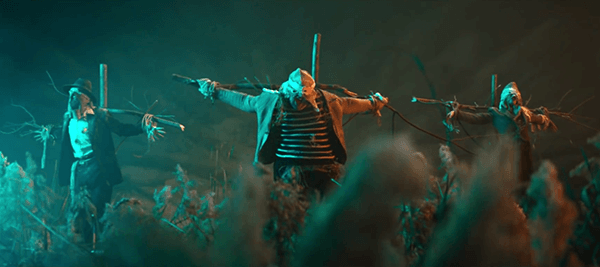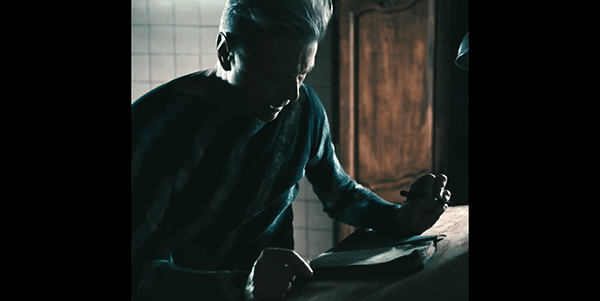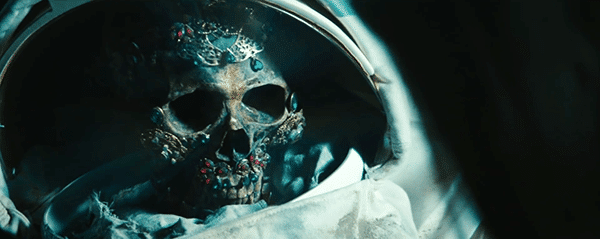Music Business
The Occult Universe of David Bowie and the Meaning of “Blackstar”

In the wake of David Bowie’s death, his last album, “Blackstar”, is his swan song, an enigmatic conclusion to a career punctuated by otherworldly alter-egos and esoteric symbolism. We’ll look at the meaning of “Blackstar” in the context of David Bowie’s career.
Very few artists can boast the longevity of David Bowie in the music industry, as his career spanned over five decades and produced 28 albums. Throughout the decades, Bowie migrated from one musical genre to another, and even from one persona to another, but a constant remained: He was surrounded by an otherworldly aura.
Through his work, Bowie turned himself into a musical ‘ascended master’, a Gnostic Christ-like figure who achieved a high level of illumination and who sought to communicate a cryptic message to humanity. While many of Bowie’s eccentricities could be attributed to drugs and rock and roll, one cannot paint a complete picture of this artist without mentioning his most enduring obsession: Western occultism.
David Bowie, born as David Robert Jones in 1947, is seen by some as a sort of ‘Renaissance Man’ whose professed ‘universality’ is an attempt to show the apex of evolution by reassembling the fragmentary pieces of our society; thus, he resembles many occultists.
However unlike most occultists, Bowie has considerable wealth, critical acclaim, penetrating intelligence, and enduring good looks; he seems set to go on to even greater heights and achievements. What next, godhead? There is a Faustian/Mephistophelean element here. How else can one explain the absolute zenith of this man’s worldly trajectory? In fact, there are people who are convinced that his brobdingnagian success is not without some kind of otherworldly assistance. (…)
Nevertheless, it can not be ignored that Bowie has constructed his public persona from the various parts of the puzzle that are at the roots of modern occultism. He was summoning up some of these pieces at the early age of 16.
– Peter R. Koenig, The Laughing Gnostic – David Bowie and the Occult
Throughout his career, Bowie often turned himself into a mere vessel as he lent his body to various personas who spoke through him, often communicating messages of deep occult significance.
Bowie’s final album Blackstar is no exception. In fact, it is a “meticulously planned” final chapter of the “Book of Bowie”, one that confirms the true meaning of his work and the occult inspiration behind it. Therefore, in order to understand Blackstar, one must first understand some of his most iconic imagery.
Occult Bowie
If one had to select a quote that would aptly sum up the Occult David Bowie, it would probably be this one:
“I’m closer to the Golden Dawn
Immersed in Crowley’s uniform
I’m not a prophet or a stoneage man
Just a mortal with potential of a superman”
– Quicksand
In these four lines, Bowie reveals a source of his esoteric worldview: the secret society Golden Dawn.
“The Golden Dawn was a magical secret society, a crowning glory of the occult revival which flourished at the end of the 19th century and taught a unique blend of Jewish mysticism (called Cabbala or Kabbalah, also to be found in Bowie’s symbolism), astral travel, magic, yoga (also practiced by Bowie) and how to communicate with angels and demons. For this latter communion it was first necessary to empty the mind, to make room for the unknown to enter – something that bears a strong resemblance to Bowie’s ‘cut-up’ method of writing lyrics”.
– Ibid.
When Bowie states that he is “immersed in Crowley’s uniform”, he is referring to Aleister Crowley, the 20th Century British occultist who was a member of the Golden Dawn and a founder of the O.T.O (Ordo Templi Orientis). He was mostly known for his work in the realms of Sex Magick, Black Magick and his philosophy, the Thelema (read my full article about Crowley here).
Magick techniques have become popularised through the writings of Aleister Crowley who was once a member of the Golden Dawn, and later of the Ordo Templi Orientis (O.T.O.), which was (and still is) deeply involved with sex–magic. The public perception of both the Golden Dawn and the Ordo Templi Orientis are pseudo–masonic organisations where the aspirant (or member) goes through stages of ceremonial initiation wearing semi–Egyptian costumes — similar to the one Bowie wore for a photo session with Brian Ward in 1971.
– Ibid.

Aleister Crowley (left) and David Bowie (right) in the inner-sleeve of the CD version of Space Oddity.
In 1976 Bowie stated:
“My overriding interest was in Kabbalah and Crowleyism. That whole dark and rather fearsome never–world of the wrong side of the brain.”
– David Bowie, from “Bowie on Bowie: Interviews and Encounters with David Bowie” by Sean Egan
In a 1983 interview, Bowie added:
“I had this more–than–passing interest in Egyptology, mysticism and the Kabbalah. At the time it seemed transparently obvious what the answer to life was. My whole life would be transformed into this bizarre nihilistic fantasy world of impending doom, mythological characters and imminent totalitarianism.”
– David Bowie, Musician, May 1983
Considering the importance of occultism in Bowie’s life, the most iconic personas of his career take on an added level of significance, a level that is reinforced in Blackstar.
Major Tom
In 1969, Bowie released Space Oddity, a single that was cleverly released only nine days before the moon-landing of Apollo II, making it the unofficial theme of this historic event. The song introduced Major Tom, an astronaut who was launched in space and whose ultimate fate remained uncertain. The song indeed finishes with the words:
“Here am I floating ’round my tin can
Far above the Moon
Planet Earth is blue
And there’s nothing I can do”
– Space Oddity
On an esoteric level, Major Tom represents the ascension of mortals towards divinity – an interpretation that is apparently confirmed in the 2015 video for the song Blackstar.
In 1972, Bowie introduces a new alter ego who instead descends to Earth from the heavens.
Ziggy Stardust

The two forms of Ziggy Stardust. Left emphasizes the one-eye sign (from the album Alladin Sane) and the other emphasizes the pineal gland, aka the third eye (from The Rise and Fall of Ziggy Stardust and the Spiders from Mars).
For his fifth album, Bowie introduced the alter-ego Ziggy Stardust, an androgynous alien rock star who was sent by the “Infinites” to announce the coming of Starmen to Earth.
In Bowie’s visionary performance, civilization was going to collapse and the ‘Infinites’ would arrive. Ziggy Stardust was to announce the coming of these ‘starmen’ bringing hope. Ziggy is their prophet, the messiah who takes himself to incredible spiritual heights, and is kept alive by the devotion of his disciples. When the Starmen finally arrive, they take bits and pieces of Ziggy so they can manifest themselves as real physical beings. Eventually they tear him to pieces on stage during the performance of the song ‘Rock’n’Roll Suicide’. At the moment of Ziggy’s death, the Starmen take on his essence, and become visible.
– Ibid.
With Ziggy Stardust, Bowie embodied the archetype of the “dying god”, a savior sent from above who ends up sacrificing his life.
The androgynous nature of Ziggy Stardust occultly represents a state of a higher spiritual level. In occultism, the highest stage of illumination is achieved through the internalization of duality and the equilibrium between opposing forces – good and evil, active and passive, male and female. This concept is symbolically represented by the horned, hermaphrodite god Baphomet. It is also represented in alchemical symbolism such as the Alchemical Androgyne.

This symbol from the Turbæ Philosophorum (1750) represents a hermaphroditic figure as the accomplishment of the magnum opus. The active and passive principles of Nature were often depicted by male and female figures, and when these two principles were harmoniously conjoined in any one nature or body it was customary to symbolize this state of perfect equilibrium by the composite figure above shown.
Ziggy Stardust also embodies the opposite of the spiritual and the material worlds: While he represents a high level of spiritual illumination, he is also a bisexual, promiscuous rock star bent on heavy drug use.
Contrarily to Major Tom who ascended from Earth to the skies, Ziggy Stardust descends from the “heavens”. He is a “higher being” who takes the form of a human in order to communicate a message, not unlike Jesus Christ.
Station to Station
In 1976, Bowie released Station to Station, an album he claimed to barely remember recording, mainly due to heavy cocaine use. He even added that it was the work of “an entirely different person,”.
“Bowie himself remembers almost nothing of the album’s production, not even the studio, later admitting, “I know it was in LA because I’ve read it was”.
Despite this fact, the album dealt with heavy occult symbolism. The song Station to Station, referred to travel through the Kabbalistic Tree of Life.
“Here are we
One magical movement
from Kether to Malkuth”
– Station to Station
“Kether” and “Malkuth” are two of the 10 elements of the Kabbalistic Tree of Life — the highest and lowest parts, respectively.

If you follow the path described by Bowie above, Keter to Malkhut describes the descent from Godhead to the physical realm. The theme of “descent from the heavens” has always been at the core of Bowie’s work.
In a 1997 interview, Bowie expands on the “magickal” meaning of the song and how no mainstream sources ever addressed it.
“The “Station to Station” track itself is very much concerned with the stations of the cross. All the references within the piece are to do with the Kabbala. It’s the nearest album to a magick treatise that I’ve written. I’ve never read a review that really sussed it. It’s an extremely dark album. Miserable time to live through, I must say.”
– Q Magazine, ChangesFiftyBowie”, 1997
On the cover art of the album we find Bowie drawing the Kabbalistic Tree of Life:
Several decades later, in 2015, Bowie is confronted with his own mortality and feels the need to offer his fans one final offering. Blackstar takes all of the elements mentioned above (and more) to create one final, enigmatic, ritualistic drama.
Blackstar
Released two days before his death, Blackstar is David Bowie’s swan song in which he wraps up the mythology he has cultivated for five decades. The video of the same name is a tapestry of dark images. At the center of it all: A human being becoming a god.
Is this Major Tom? Are we seeing his final resting place? A young girl opens the astronaut’s helmet and finds an ornate skull.
The skull is then revered as some kind of artifact from the gods.

A “grand priestess” holds the skull between two rows of women who cannot help trembling in its presence.
Sung in the matter of an incantation, the lyrics of the first verse allude to an occult ritual:
In the villa of Ormen, in the villa of Ormen
Stands a solitary candle, ah-ah, ah-ah
In the centre of it all, in the centre of it all
Your eyes
In the video, the men and women are separated, which conveys the idea of two opposing energies (male and female). Both groups end up making us witness an indirect sex magick ritual.

On the other, three crucified scarecrows (who appear to be animated by an unholy force), move their hips in a suggestive manner.
The combination of sex magick with the twisting of Christ’s crucifixion gives the video a strong “Crowleyian” direction.
In an interview, the director of the video, Johan Renck, discusses Crowley.
“Well, I’m a huge Crowley fan, I’ve always been. I tried to make a movie on his life a few years ago but we didn’t manage to put it together. I love Crowley for being an audacious man at certain point in time. I think he’s greatly misunderstood. He was a good guy, but he was portrayed as an evil man and he wasn’t.”
– Vice News, Behind “Blackstar”: An Interview with Johan Renck, the Director of David Bowie’s Ten-Minute Short Film
The name of the album itself, Blackstar, refers to an important occult concept: the Midnight Sun.
“Apuleius said when describing his initiation (vide ante): “At midnight I saw the sun shining with a splendid light.” The midnight sun was also part of the mystery of alchemy. It symbolized the spirit in man shining through the darkness of his human organisms. It also referred to the spiritual sun in the solar system, which the mystic could see as well at midnight as at high noon, the material earth being powerless to obstruct the rays of this Divine orb. The mysterious lights which illuminated the temples of the Egyptian Mysteries during the nocturnal hours were said by some to be reflections of the spiritual sun gathered by the magical powers of the priests. The weird light seen ten miles below the surface of the earth by I-AM-THE-MAN in that remarkable Masonic allegory Etidorhpa (Aphrodite spelt backward) may well refer to the mysterious midnight sun of the ancient rites.”
– Manly P. Hall, The Secret Teachings of All Ages
Bearing in mind Bowie’s impending death, the lyrics of the song take on a very personal meaning:
“Something happened on the day he died
Spirit rose a metre and stepped aside
Somebody else took his place, and bravely cried
(I’m a blackstar, I’m a blackstar)”
– Blackstar
Is Bowie referring to his own death? Is he referring to his spirit-less body being taken over by a Blackstar? This is yet another allusion to Bowie being “taken over” by a mysterious being who states:
I’m the Great I Am (I’m a blackstar)
“I Am that I Am” is the response God used in the Hebrew Bible when Moses asked for his name.
In the video, Bowie plays the role of three separate characters.

The “blind follower” with buttons instead of eyes. This character represents the simple, ignorant man.

The “flamboyant trickster” who appears to have taken over Bowie’s aging body with eccentric mannerisms.
The video, therefore, depicts the several layers associated with occult knowledge. There are those who are in direct contact with its “true source” while the blind masses are fascinated by a bastardized version of it, sold by charismatic figures. David Bowie indicates that he is, simultaneously, a blind simple man and an occult initiate – a Blackstar.
Lazarus
Bowie’s final video bears the name of a significant Biblical figure: Lazarus.
In the New Testament, Lazarus died of an illness and was resurrected four days later by Jesus Christ. In the context of Bowie’s terminal illness, the title Lazarus conveys the idea of immortality, while playing with the constant idea of him being from “another world”.
In the video, Bowie plays the role of the same characters as in Blackstar.

In the role of the “blind man”, Bowie is an aging human who is physically weak, laying on his deathbed and scared of things to come.
Look up here, I’m in heaven
I’ve got scars that can’t be seen
I’ve got drama, can’t be stolen
Everybody knows me now
– Lazarus
From a dresser in the corner of the room (possibly symbolizing a portal to another dimension), emerges another Bowie, the flamboyant, eternally-young Bowie.
The costume worn by this Bowie refers to a specific relic from his past.

Bowie wears the same outfit as seen on the cover of “Station to Station” in which he is drawing the Kabbalistic Tree of Life.
As stated above, according to Bowie, this 1976 album was written “by an entirely different person”.
In Lazarus, we witness the return of this immortal being.

With theatrical mannerisms, this Bowie writes feverishly, as if animated by a higher force. Is this the source of Bowie’s inspiration throughout the years?

At one point we see the skull from Blackstar, implying that this Bowie possesses that secret occult knowledge.
Although Bowie’s mortal body succumbed to physical illness (which is the ultimate fate of all humans), another part of him lives on, that otherworldly being who took over his body throughout his career.
In Lazarus, Bowie bids farewell to the physical world but reminds us that a part of him lives on … that same part of him that ascended into space as Major Tom and descended to Earth as Ziggy Stardust. This Bowie travels from the physical to the spiritual world with the same ease as he travels from “Station to Station” through the Kabbalistic Tree of Life.
In Conclusion
Although David Bowie’s career spanned several decades, produced 28 albums, and exploited all kinds of enigmatic concepts, one aspect remained constant: He projected the aura of an otherworldly being, one that did not really belong on Earth, that sometimes appeared to be either spiritually illuminated or demonically possessed.
His final album, Blackstar is a direct continuation of the “Bowie mythos”. Meticulously planned to turn his death into a work of art, the imagery of Blackstar ties together several iconic moments of Bowie’s career into one final narrative, one that confirms the extreme importance of occultism in his work.
Lazarus, Bowie’s final parting gift, conveys one important message: Bowie was a vessel to something greater, something deeper, something darker, and something more profound than most ever realized. Claiming “I am the Great I Am”, this Being gave Bowie the inspiration to become an immortal icon and lead his fans to rally behind the declaration that “Bowie is God”.
Was Bowie truly influenced by unseen occult forces or was he simply a brilliant entertainer with a penchant for dramatics? Bowie answered this question a long time ago:
“I’m closer to the Golden Dawn
Immersed in Crowley’s uniform
I’m not a prophet or a stoneage man
Just a mortal with potential of a superman”
- Is Bill trying to tell us something?
- 'Lady popular' game ad
- Kanye West dons Jesus Christ mask in wild 2021 deposition video
- CDC confirms first human "severe" case of H5N1 (bird flu)
- Pope Francis Will Be Opening 5 Sacred Portals For A Special Catholic Ritual On Christmas Eve
- Satanists erect display at Minnesota State Capitol
- Satanic holiday display at Minnesota Capitol causes controversy
Get an e-mail notification as soon as a new article is published on The Vigilant Citizen.
-

 Latest News3 months ago
Latest News3 months agoThe Controlled Demolition of Diddy
-

 Pics of the Month2 months ago
Pics of the Month2 months agoSymbolic Pics of the Month 10/24
-

 Movies and TV2 months ago
Movies and TV2 months agoAn In-Depth Look at the Hidden Meaning and Symbolism in “Blink Twice”
-

 Latest News1 month ago
Latest News1 month agoKamala’s Campaign Was Objectively the Worst in Recent History
-

 Movies and TV3 weeks ago
Movies and TV3 weeks agoAdrenochrome and Ritual Humiliation: The True Meaning of the Movie “The Substance”
-

 Movies and TV3 months ago
Movies and TV3 months agoAn In-Depth Look at the Dark Messages and Symbolism in “Longlegs”
-

 Latest News1 month ago
Latest News1 month agoWas the Jake Paul vs Mike Tyson Fight a Humiliation Ritual?
-

 Latest News2 months ago
Latest News2 months agoAn “Urban Opera” in Toulouse Using Massive Machines is Denounced as a Satanic Ritual



























